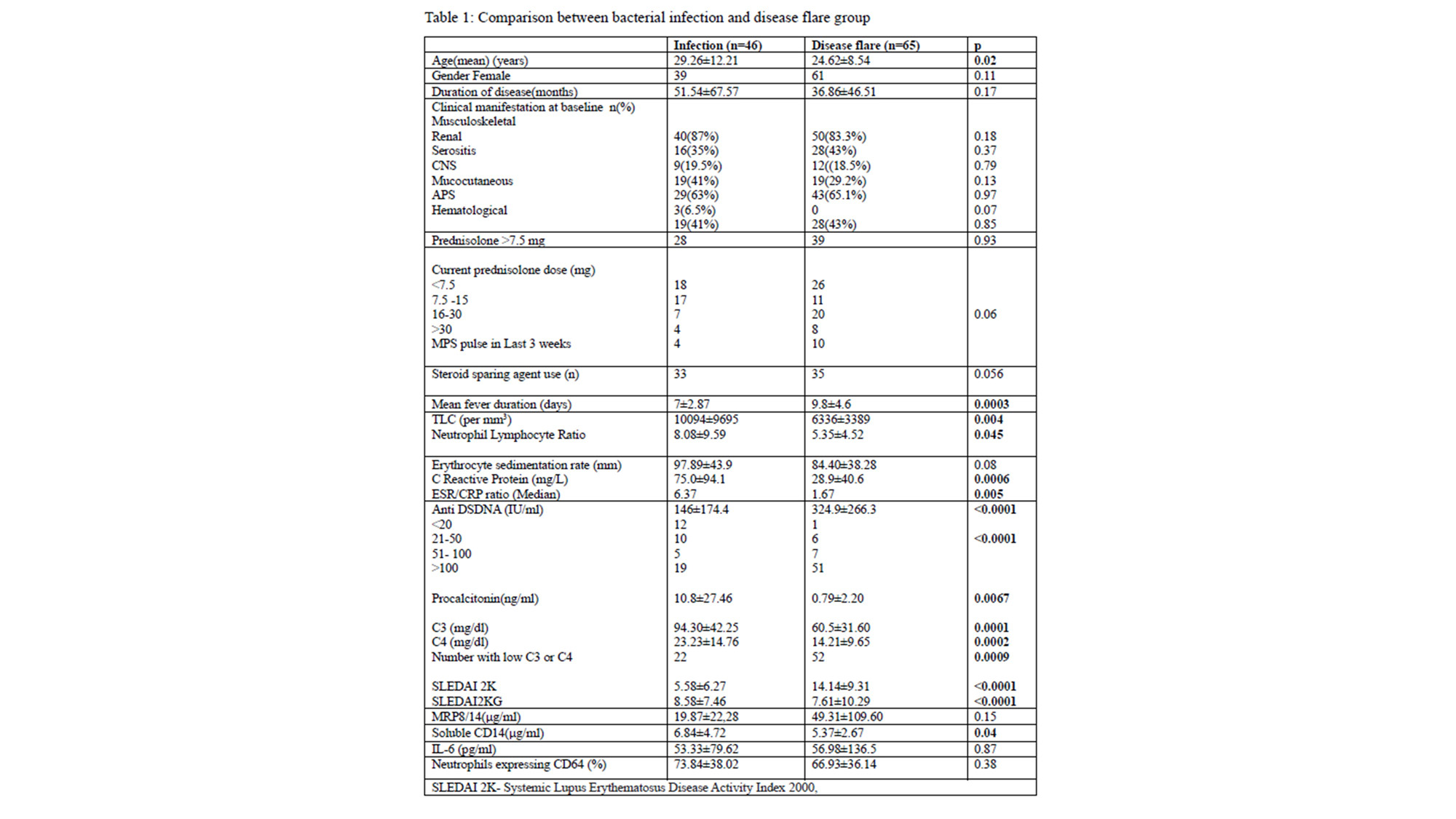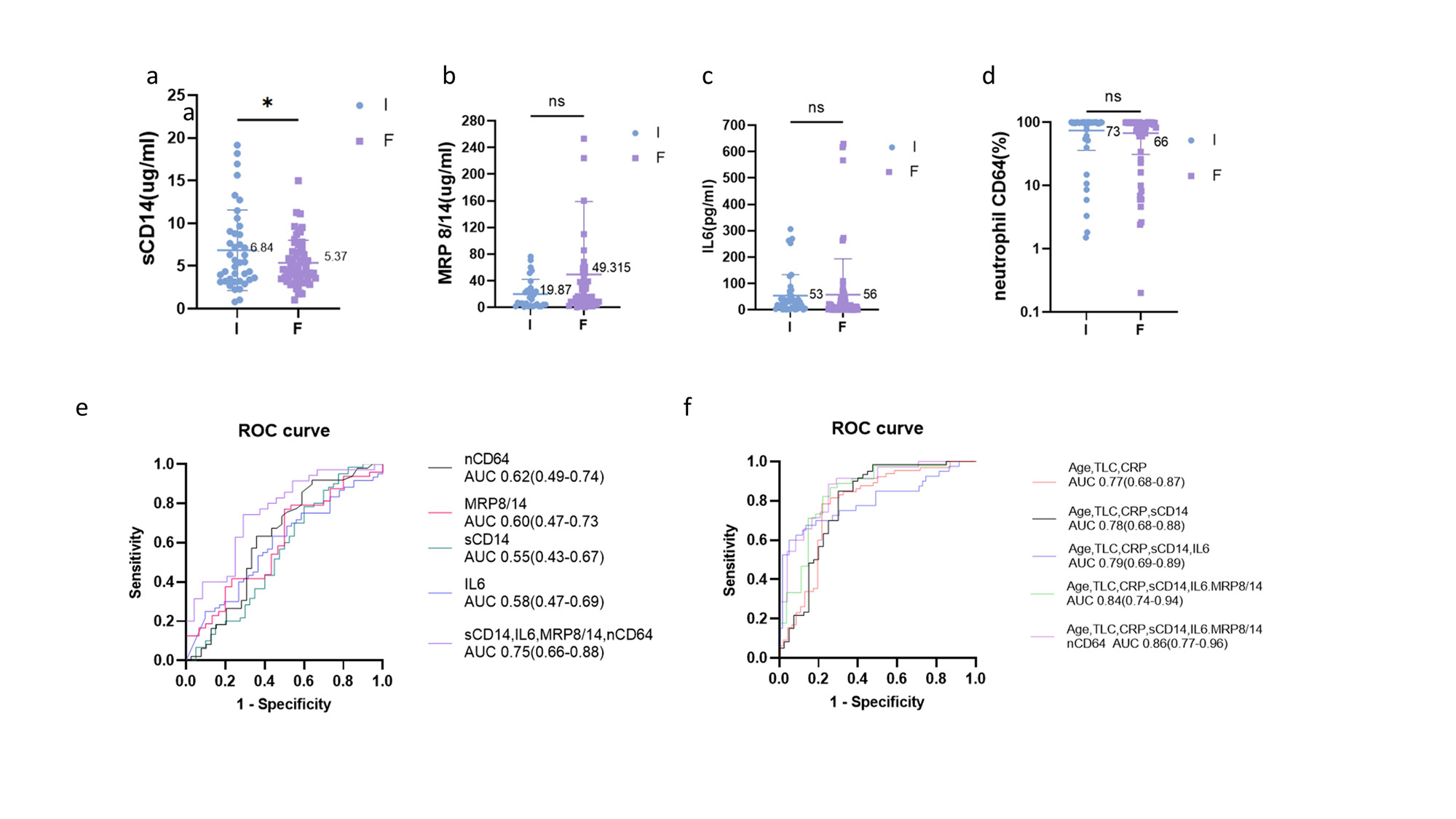Session Information
Date: Sunday, November 12, 2023
Title: Abstracts: SLE – Diagnosis, Manifestations, & Outcomes I: Biomarkers
Session Type: Abstract Session
Session Time: 4:00PM-5:30PM
Background/Purpose: Disease flare and infections are the major causes of fever in a patient with SLE. It is vital to differentiate between these two as escalation of immunosuppressive treatment can be disastrous in a patient with infection. A low-cost calculator was recently described for differentiation (Lupus. 2022;31:1254-1262). Newer biomarkers are being explored and data on sepsis markers like MRP8/14, IL-6, sCD14 and neutrophil CD64 is limited in SLE. Thus, we evaluated these 4 markers in febrile SLE patients for their utility as well as their ability to improve performance of this low-cost calculator.
Methods: Patients with SLE who had fever of more than 2 days, but less than 2 weeks duration were included in the study. Patients were evaluated in detail for infection and fever episode was classified as infection, disease activity or combination of both. Complete blood counts, erythrocyte sedimentation rate (ESR), C-reactive protein (CRP), procalcitonin, complement C3 and C4, anti-dsDNA antibodies were measured. In addition, soluble CD14 (sCD14), Myeloid related protein (MRP) 8/14 and interleukin (IL)-6 were measured by ELISA. neutrophil CD64 expression was measured by flowcytometry and is expressed as % of neutrophil expressing CD64.
Among patients with infection episode and disease flare the variables were analyzed using Mann Whitney-U test for continuous and chi-square for categorical variables respectively, ROC curve analysis was used for test performance.
Results: 156 episodes of fever were studied. The mean age of the patients was 26.8 years while the mean duration of disease was 3.5 years. Among 156 episodes, 52 were because of infection while 65 were related to disease flare and 38 were due to combination of two and 1 due to malignancy.
Among 52 patients with infection, 46 had bacterial infection, 4 had tuberculosis and 1 each had fungal and viral infection. Among patients with bacterial infection, the site of infection was lower respiratory tract in 17, urinary tract infection in 14, skin and soft tissue in 3, meningitis in 2 and gastrointestinal in 4 and others in 6.
Patients with infection had higher CRP, procalcitonin, neutrophil to lymphocyte ratio while patients with disease activity had lower C3, C4 and higher anti-dsDNA antibodies and SLEDAI2K (Table 1).
The levels of sCD14 were higher in patients with infection whereas the level of IL-6 and MRP8/14 were no different between the two groups. Neutrophil CD64 expression was also not different between the two groups. (Figure 1a-d).
On ROC curve analysis the new biomarkers had AUC between 0.55 to 0.62 and in combination they had an AUC of 0.75. (Figure 1e). When three or all of the newer biomarkers were added to a recently described calculator comprising of age, TLC, and CRP, it improved its performance from AUC of 0.77 to 0.86. (Figure 1f)
Conclusion: Newer biomarkers of sepsis like MRP8/14, IL-6, sCD14 and neutrophil CD64 expression in combination have modest performance to differentiate flare from infection. Addition of these biomarkers in combination improved the accuracy of recently described calculator.
To cite this abstract in AMA style:
Majithiya K, Singh K, Mehta P, Kavadichanda C, Sharma s, Lawrence A, Aggarwal A. Performance of Serum MRP8/14, sCD14, IL-6 and Neutrophil CD64 in Isolation and in Combination for Differentiating Flare from Bacterial Infection in Febrile SLE Patients [abstract]. Arthritis Rheumatol. 2023; 75 (suppl 9). https://acrabstracts.org/abstract/performance-of-serum-mrp8-14-scd14-il-6-and-neutrophil-cd64-in-isolation-and-in-combination-for-differentiating-flare-from-bacterial-infection-in-febrile-sle-patients/. Accessed .« Back to ACR Convergence 2023
ACR Meeting Abstracts - https://acrabstracts.org/abstract/performance-of-serum-mrp8-14-scd14-il-6-and-neutrophil-cd64-in-isolation-and-in-combination-for-differentiating-flare-from-bacterial-infection-in-febrile-sle-patients/


